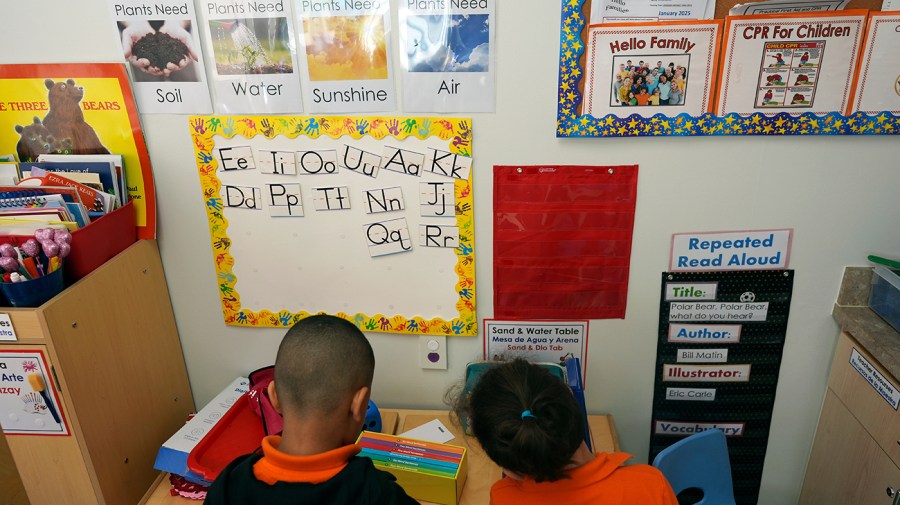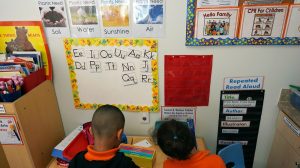Head Start programs in danger after government shutdown funding lapse

Head Start, a free learning program for children from low-income families, is next on the chopping block as the government shutdown nears record length.
More than 100 Head Start programs are in danger of closing soon or already shuttering some operations after funding didn’t come on a Saturday deadline.
“There’s both the effect on young children and the effect on their parents and families and the broader community,” said Melissa Boteach, chief policy officer of Zero to Three.
“This is high-quality early education that includes a lot of wrap-around services and early screening, all kinds of things that help kids to have the strongest possible start,” Boteach added. “It’s also a really important form of child care … You have a work commitment, and, all of a sudden, you’ve come to find out that because Congress has not opened the government, that you don’t have child care on Monday.”
Nationwide, Head Start serves more than 750,000 children. Last year, the federal government provided $12 billion to the programs.
That money was distributed to 1,600 different grant recipients nationwide, and the programs have different start dates for funding, rotating the first of each month across all 12 months.
In October, which was the first month for the shutdown, only 6 programs were impacted. But for November, another 134 Head Start programs lost funding.
“November programs serve more than 65,000 children and families, and they are doing everything that they possibly can to keep their doors open,” said Tommy Sheridan, deputy director of the National Head Start Association.
While some have reserves they can tap into, most of these programs are expected to close quickly or by the end of the month.
“They’re going to be doing everything that they can to find other resources … they’re leveraging reserve funds. They’re leveraging partnerships with school districts, some states that are chipping in. Some have leveraged philanthropy. Others have lines of credit — really a wide array of additional resources they’re trying to tap into to provide basically temporary reprieve to be able to keep operation,” Sheridan said.
The Department of Health and Human Service, like the rest of the Trump administration, is publicly blaming the Democrats for the shutdown and says once it is lifted, the office will expedite awards for Head Start programs that missed their payments.
Pressure is mounting on both parties to reach a deal to end the shutdown soon as funding for government programs dwindles and benefits such as food stamps are in danger of running dry.
One Head Start center in Vancouver, Wash., closed multiple classrooms Monday due to the lapse in funding.
Joel Ryan, executive director of the Washington State Association of Head Start and Early Childhood Education and Assistance Program, said rural Head Start programs are likely to close first due to the lack of resources and reserves to keep going.
“Programs that are in more rural and remote areas are more fragile in sort of the constant, I would say, constant assault by the Trump administration and Congress, whether it’s Head Start or other programs that impact kids and families because they don’t have other resources,” Ryan said.
“One of my Head Start programs in Seattle, they’re able to use some cash reserves. They have a little bit more financial flexibility, but the smaller programs don’t have that. They don’t have those available resources,” he added.
But even bigger programs only have a limited amount of resources before they have to make changes, such as shutting down classes or laying off staff.
Furloughing or laying off staff only creates more problems, as there is a shortage of child care workers and many in the field are struggling themselves.
Forty-three percent of early educator families depend on at least one form of public support, such as food stamps, to survive, according to the Center for the Study of Childcare Employment. Government assistance programs are also in turmoil due to the shutdown.
“At some point, many educators are coming to the conclusion that they don’t know if they have a stable job and they might need to look elsewhere or find something else to do, even though they love working with young children,” said Boteach.
And once December hits, a new round of Head Start programs will lose funding, and the cycle will grow until the shutdown is over.
“Most Head Start programs will still be there to provide the critical services that Head Start provides to children and families, but there is a strong, sizable number that will be forced to close and more and more as the shutdown drags on,” Sheridan said.






